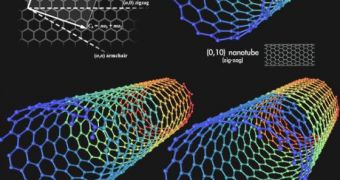Carbon nanotubes have long been touted as a very promising material in areas such as engineering and computer sciences, but it now seems that medicine has good uses for them as well. A large collaboration of scientists at the Wake Forest University School of Medicine, the Wake Forest University Center for Nanotechnology and Molecular Materials, the Rice University and Virginia Tech has recently devised a new method of fighting cancer. In unsuspecting mouse models, the new course of treatment proved to have an 80-percent efficiency rate. Details of the method appear in the August issue of the journal Proceedings of the National Academy of Sciences (PNAS).
In the new experiments, the researchers inoculated rodents with tumors, and waited until they got sufficiently large to be life-threatening. Then, they injected carbon nanotubes directly within the cancer, and zapped the entire area with a 30-second laser pulse. The light heated the nanotubes, which in turn emitted enough heat to kill off surrounding tumor cells. In 80 percent of the cases, the mice survived the initial tumor, and were reported free of cancer. The research brings hope to cancer patients, as there is a high probability the method will work on humans as well.
“When dealing with cancer, survival is the endpoint that you are searching for. It's great if you can get the tumor to shrink, but the gold standard is to make the tumor shrink or disappear and not come back. It appears that we've found a way to do that,” Wake Forest University School of Medicine Professor of Biochemistry Suzy Torti, PhD, who has also been the lead investigator for the new study, says.
With the new therapy, “You can actually watch the tumors shrinking until, one day, they are gone. Not only did the mice survive, but they maintained their weight, didn't have any noticeable behavioral abnormalities and experienced no obvious problems with internal tissues. As far as we can tell, other than a transient burn on the skin that didn't seem to affect the animals and eventually went away, there were no real downsides – that's very encouraging,” the expert adds.
Scientists selected to use multi-walled carbon nanotubes (MWCNT) for their attempt to destroy tumors. They have the ability to respond to near-infrared laser light, and to vibrate in response. These vibrations in turn generate heat, which destroys neighboring cells. The new method even proved to be more successful than the heat therapy radiofrequency ablation, which is only able to heat single points, and not entire tumors.

 14 DAY TRIAL //
14 DAY TRIAL //